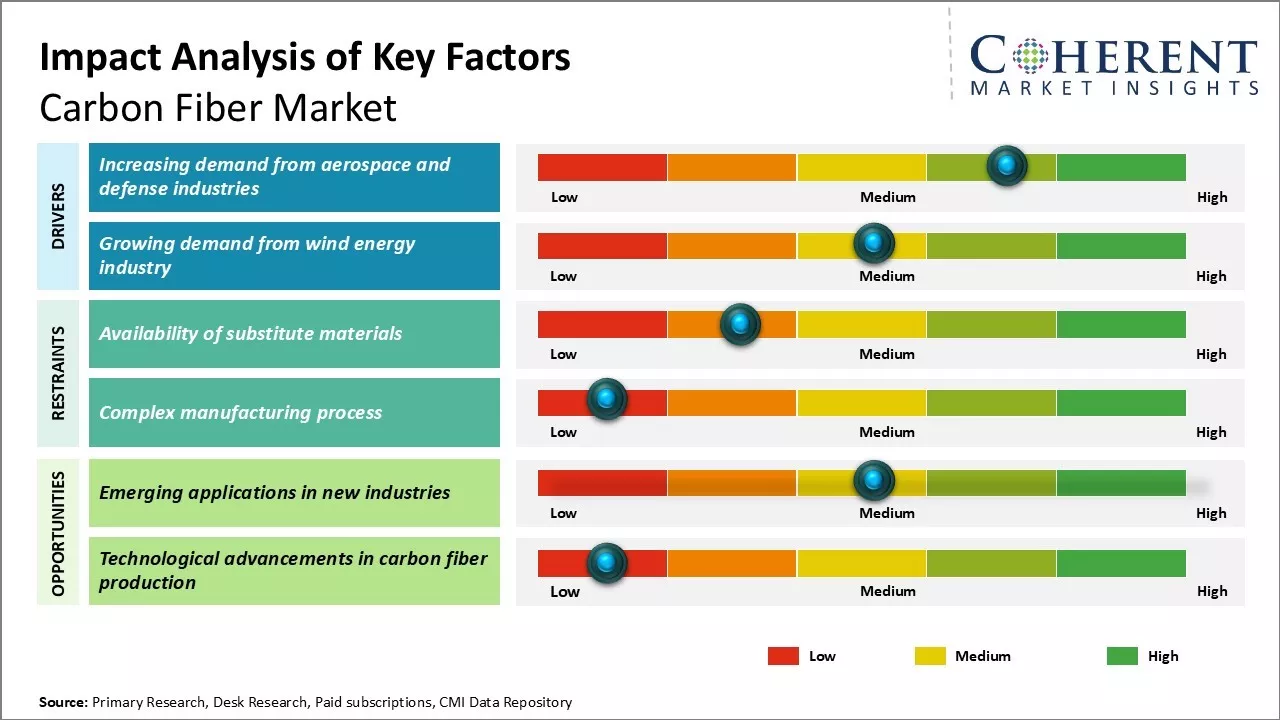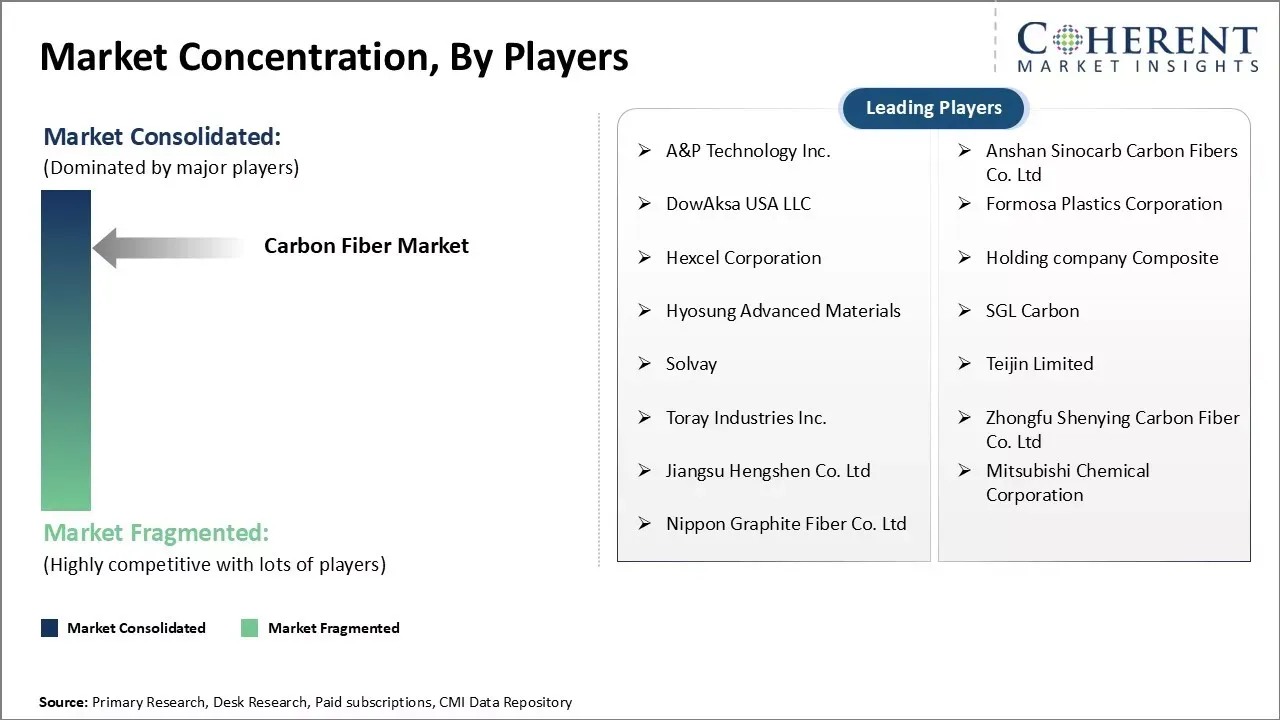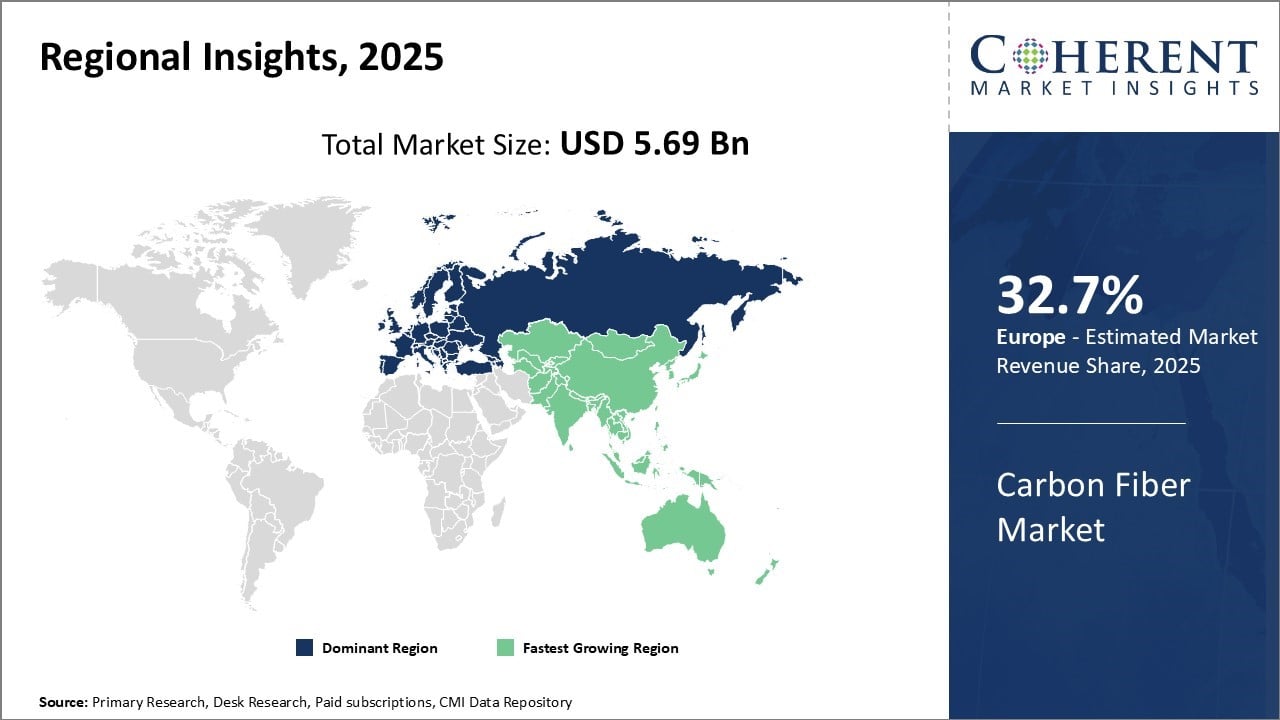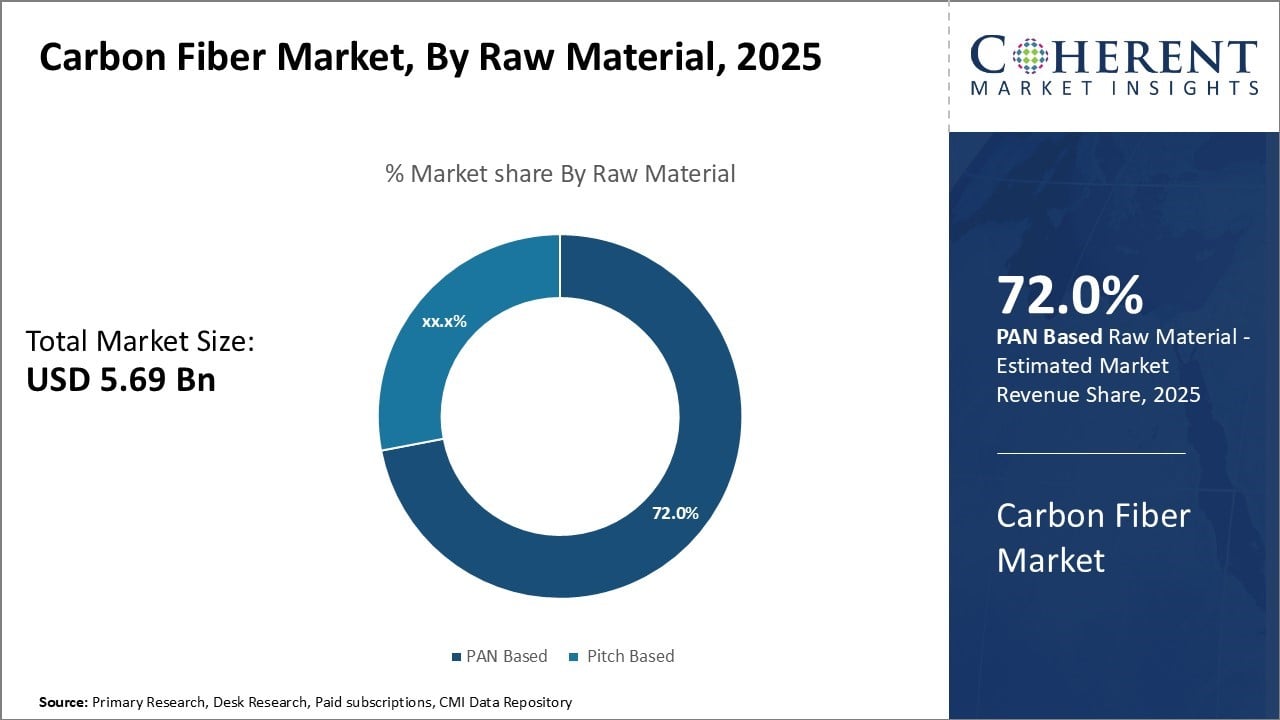Carbon Fiber Market Size and Trends Forecast: 2025 - 2032
The carbon fiber market is estimated to be valued at USD 5.69 Bn in 2025 and is expected to reach USD 10.33 Bn by 2032, exhibiting a compound annual growth rate (CAGR) of 8.9% from 2025 to 2032.
Key Takeaways of the Carbon Fiber Market
- By raw material, the PAN based segment is expected to contribute the highest share of the carbon fiber market with 72. 0% in 2025.
- By tow size, the small tow segment is expected to contribute the highest share of the market with 52. 8% in 2025.
- By application, the automotive segment is expected to contribute the highest share of the carbon fiber market with 20. 8% in 2025.
- Europe is expected to top the global market with 32. 7% share in 2025.

To learn more about this report, Download Free Sample
Market Overview
Carbon fibers witness huge demand from industries, such as aerospace & defense, wind energy, automotive & transportation, and others, due to its lightweight and high tensile strength properties. Key factors boosting the demand for carbon fiber include growing aerospace industry with increased aircraft deliveries and development of low-cost carbon fibers. Stringent environmental regulations mandating the reduction of vehicular weight also boosts the adoption of carbon fiber composites in the automotive industry.
However, key challenges faced by the carbon fiber market include the availability of substitute materials. While carbon fiber composites provide higher strength and lesser weight compared to traditional materials like steel and aluminum alloys, their cost is also significantly higher.
Market Concentration and Competitive Landscape

To learn more about this report, Download Free Sample
Current Events and their Impact on the Carbon Fiber Market
|
Current Events |
Description and its impact |
|
Trump's 2025 Tariffs on Advanced Materials and Aerospace Components |
|
|
China's Carbon Fiber Market Overcapacity and Global Supply Chain Disruption |
|
Uncover macros and micros vetted on 75+ parameters: Get instant access to report
Market Trends
Increasing Demand from Aerospace and Defense Industries
Aerospace and defense industries have witnessed significant development in recent years. With commercial aviation growing rapidly to support increased global air travel, there has been huge demand for innovative yet lightweight materials that can enhance aircraft performance. Aerospace industry opt for carbon fiber composites to replace aluminum, steel and titanium, based on studies by NASA.
Carbon Fiber Market Insights, By Raw Material: Pursuit of Lightweight and High Strength Materials Boosts the Demand for PAN Based Carbon Fiber
In terms of raw material, the PAN based segment is estimated to contribute the highest market share of 72.0% in 2025, owing to its superior mechanical properties compared to pitch-based carbon fiber.
PAN based carbon fiber offers high tensile strength, reaching over 5GPa and modulus exceeding 250 GPa, making it an irreplaceable material for numerous high-performance applications. Its low density of around 1.8 g/cm3 further boosts its appeal from a weight saving perspective.
Carbon Fiber Market Insights, By Tow Size: Superior Properties of Small Tow Carbon Fiber Spur Usage in Smaller Composite Components
In terms of tow size, the small tow segment is estimated to contribute the highest market share of 52.8% in 2025, owing to its suitability for fabrication of intricate, compact composite parts.
In contrast, the finer filaments of small tow carbon fiber can be more precisely arranged and deposited using automated fiber placement (AFP) and filament winding techniques. This enables intricately shaped or hollow components to be mass produced for applications such as turbine blades.
Carbon Fiber Market Insights, By Application: Growing Use of Carbon Fiber in Automotive Drivetrains and Chassis Propels Application in this Segment
In terms of application, the automotive segment is estimated to contribute the highest market share of 20.8% in 2025, owing to ongoing mass adoption in drivetrain and body construction.
Meeting increasingly stringent emissions regulations drives automakers to decrease vehicle weight and improve efficiency. Carbon fiber helps achieve this goal through applications like transmission gears, half-shafts, battery housings and motor casings in electric vehicles.
Emerging Innovations in the Carbon Fiber Market
- Advancements in Resin Systems and Matrix Materials
- Advancements in resin systems and matrix materials have enabled carbon fiber composites to perform better under extreme conditions. High-temperature thermoset resins, thermoplastics, and recyclable or repairable matrix materials are significantly improving the durability, fatigue resistance, and recyclability of carbon fiber components. This evolution allows for more sustainable and cost-effective lifecycle management of carbon fiber parts in sectors like automotive and wind energy, where regulatory standards and environmental considerations are increasingly stringent.
- Carbon Nanotube (CNT)
- Carbon nanotube (CNT) reinforced carbon fibers and hybrid fiber composites amalgamate the mechanical benefits of carbon fibers with the exceptional electrical, thermal, and mechanical characteristics of CNTs. These hybrid materials enable applications requiring electrical conductivity alongside structural strength, such as electromagnetic interference shielding in aerospace and electronics devices.
Impacts of Artificial Intelligence (AI) on the Carbon Fiber Market
By integrating AI into core processes, companies are enhancing production efficiency, optimizing design, and creating smarter applications that deliver measurable benefits.
- An illustrative case is Solvay, which launched an AI-enhanced resin system designed for carbon fiber composites used in automotive lightweighting. By integrating AI algorithms that simulate and optimize resin curing cycles, Solvay’s solution ensures optimal bonding and structural integrity. Automakers using these composites benefit from reduced vehicle weight, leading to better fuel efficiency and lower emissions without compromising safety.
- Toray Industries, a global carbon fiber powerhouse, employs AI-based image recognition systems to detect microscopic flaws during the fiber weaving and resin infusion stages. This automated inspection replaces traditional manual methods, significantly reducing inspection time and improving detection accuracy. As a result, manufacturing yields improve, and the risk of part failure in critical applications is minimized, enhancing reliability for end-users.
Regional Insights

To learn more about this report, Download Free Sample
Europe Carbon Fiber Market Analysis and Trends
Europe is expected to dominate the carbon fiber market in 2025, with an estimated market share of 32.7%. The market growth can be attributed to the region's well-established aerospace and automotive industries. Major players like Boeing, Airbus, and Ford have boosted demand for fibers. Government initiatives to boost advanced manufacturing have also contributed to an expansive ecosystem for carbon fibers in the region.
For instance, Epsilon Composite and Toray Carbon Fibers Europe have marked 15 years of collaboration championing carbon‑fiber composite core conductors (HVCRC), fusing Torayca carbon fiber with aluminum strands to modernize global high‑voltage grids. Their long-running partnership recently led to a strategic framework agreement with TenneT in the Netherlands to deploy this technology across the country’s 400 kV infrastructure.
Asia Pacific Carbon Fiber Market Analysis and Trends
Asia Pacific exhibits the fastest growth, due to growing end-use industries in China, Japan, India, and other emerging economies. Government policies supporting infrastructure development and mobility have accelerated carbon fiber adoption in the industrial and transportation sectors. Regional giants like Toyota, Honda, and Hyundai are localizing carbon fiber production to meet demand.
For instance, according to Instituto Granado de Tecnologia da Poliacrilonitrila (IGTPAN), majority of the world production of carbon fiber is located in Asia (40%) and approximately 90% of the world's carbon fiber production uses PAN fibers as a precursor, the remaining being produced with other raw materials such as tar and rayon.
Carbon Fiber Market Outlook for Key Countries
Japan Carbon Fiber Market Analysis and Trends
Japanese companies, such as Toray Industries and Mitsubishi Chemical, have pioneered high-performance carbon fiber manufacturing, focusing on material strength, weight reduction, and temperature resilience. Innovations in resin-infused carbon fiber composites and high-tensile materials have propelled Japan to the forefront of carbon fiber technology. Japan has invested heavily in automated manufacturing processes, which reduce production costs and increase the scalability of carbon fiber production.
China Carbon Fiber Market Analysis and Trends
China's market is growing aggressively following initiatives to build domestic manufacturing capacity. State funding and partnerships between global firms and local players have positioned China as both a key consumer and emerging producer of carbon fiber.
According to macropolo.org data published in 2023, China’s wind power boom gave the incentive the private sector needed to kick carbon fiber production into high gear—a feat never achieved by the state firms that poured money into the material in the mid-2000s.
Germany Carbon Fiber Market Analysis and Trends
Advanced engineering capabilities makes Germany an important market for carbon fiber application. Carbon fiber usage is rising across industries ranging from aerospace to renewable energy supported by firms like SGL Group. Automotive (especially electric vehicles), aerospace, and wind energy are primary consumers of this fiber. Germany is a leader in wind energy technology, and demand for high-performance materials like carbon fiber has been rising.
France Carbon Fiber Market Analysis and Trends
French aerospace industry, led by companies like Airbus, is a key consumer of carbon fiber. The government’s commitment to green energy boosts demand in renewable sectors. Aerospace, wind energy, and construction industries are the main consumers of this fiber. France’s push for decarbonization and sustainable aviation fuels highlights carbon fiber’s role in light weighting aircraft.
Pricing Analysis of the Carbon Fiber Market
- Standard Modulus Carbon Fiber: USD 12–20/kg
- Intermediate Modulus Carbon Fiber: USD 20–35/kg
- High Modulus Carbon Fiber: USD 35–50/kg
- Ultra-High Modulus Carbon Fiber: USD 60+/kg
Market Report Scope
Carbon Fiber Market Report Coverage
| Report Coverage | Details | ||
|---|---|---|---|
| Base Year: | 2024 | Market Size in 2025: | USD 10.33 Bn |
| Historical Data for: | 2020 To 2024 | Forecast Period: | 2025 To 2032 |
| Forecast Period 2025 to 2032 CAGR: | 8.9% | 2032 Value Projection: | USD 5.69 Bn |
| Geographies covered: |
|
||
| Segments covered: |
|
||
| Companies covered: |
A&P Technology Inc., Anshan Sinocarb Carbon Fibers Co. Ltd, DowAksa USA LLC, Formosa Plastics Corporation, Hexcel Corporation, Holding company Composite, Hyosung Advanced Materials, SGL Carbon, Solvay, Teijin Limited, Toray Industries Inc., Zhongfu Shenying Carbon Fiber Co. Ltd, Jiangsu Hengshen Co. Ltd, Mitsubishi Chemical Corporation, and Nippon Graphite Fiber Co. Ltd. |
||
| Growth Drivers: |
|
||
| Restraints & Challenges: |
|
||
Uncover macros and micros vetted on 75+ parameters: Get instant access to report
Carbon Fiber Industry News
- In March 2025, Mercedes announced that its 2025 car, the W16, will use innovative sustainable carbon fibre composites, marking the first time that this has been done in Formula 1. With carbon fibre composites forming approximately 75% of the team’s race car materials, helping to achieve both performance and safety – innovations in this area offer a significant opportunity to reduce the carbon footprint of the car, while also acting as another step in the Silver Arrows’ goal to achieve Net Zero across all scopes by 2040.
- In March 2025, Teijin Carbon, a producer of carbon fibers and carbon fiber-based materials, showcases its pioneering spirit in combining innovation and sustainability with the launch of Tenax Next HTS45 E23 24K carbon fiber filament yarn at JEC World 2025.
- In June 2025, Dow announced that it has signed a sale and purchase agreement to sell its 50% interest in DowAksa Advanced Composites Holdings BV (DowAksa) to Aksa Akrilik Kimya Sanayii A.Ş., a company of Akkök Holding. Aksa Aksa Akrilik Kimya Sanayii A.Ş., the other 50% joint venture partner, has agreed to acquire Dow's 50% interest.
- In June 2025, Toray Industries, Inc., a global leader in advanced composite material technologies, announced that five of its group companies will exhibit at JEC World 2025, the leading international trade show for the composites industry. The showcased technologies will include TORAYCA carbon fiber, advanced towpreg, high-performance thermoset composite materials, and Cetex thermoplastic composites, and their application development laboratories focused on research and innovation.
Analyst View
- The carbon fiber market is exhibiting robust momentum, driven primarily by its superior strength-to-weight ratio and corrosion resistance, making it increasingly indispensable across various industries. Key drivers include rising demand from the aerospace and automotive sectors, where reducing vehicle weight is critical for enhancing fuel efficiency and cutting emissions.
- Additionally, the growing adoption of carbon fiber in renewable energy applications, particularly wind turbine blades, is propelling market growth. The sports and recreation segment also contributes significantly, leveraging carbon fiber’s performance benefits in equipment like bicycles and golf clubs.
- However, high production costs and energy-intensive manufacturing processes act as notable restraints, limiting broader adoption, especially in price-sensitive markets. Efforts to develop cost-effective manufacturing techniques and recycled carbon fiber materials present substantial opportunities for market expansion. Furthermore, ongoing innovations such as automated fiber placement and 3D weaving are expected to enhance production efficiency and material performance.
- Geographically, Asia Pacific is emerging as the fastest-growing region, fueled by expanded industrialization and increased investments in aerospace and automotive manufacturing hubs in China, Japan, and South Korea. Europe continues to dominate due to well-established aerospace and defense sectors, coupled with substantial research and development (R&D) activities.
Market Segmentation
- Raw Material Insights (Revenue, USD Bn, 2020-2032)
- PAN Based
- Pitch Based
- Tow Size Insights (Revenue, USD Bn, 2020-2032)
- Small Tow
- Large Tow
- Application Insights (Revenue, USD Bn, 2020-2032)
- Automotive
- Aerospace & Defense
- Wind Turbines
- Sports/Leisure
- Molding & Compound
- Construction
- Others
- Regional Insights (Revenue, USD Bn, 2020-2032)
- North America
- U.S.
- Canada
- Latin America
- Brazil
- Argentina
- Mexico
- Rest of Latin America
- Europe
- Germany
- U.K.
- Spain
- France
- Italy
- Russia
- Rest of Europe
- Asia Pacific
- China
- India
- Japan
- Australia
- South Korea
- ASEAN
- Rest of Asia Pacific
- Middle East
- GCC Countries
- Israel
- Rest of Middle East
- Africa
- South Africa
- North Africa
- Central Africa
- Key Players Insights
- A&P Technology Inc.
- Anshan Sinocarb Carbon Fibers Co. Ltd.
- DowAksa USA LLC
- Formosa Plastics Corporation
- Hexcel Corporation
- Holding company Composite
- Hyosung Advanced Materials
- SGL Carbon
- Solvay
- Teijin Limited
- Toray Industries Inc.
- Zhongfu Shenying Carbon Fiber Co. Ltd.
- Jiangsu Hengshen Co. Ltd.
- Mitsubishi Chemical Corporation
- Nippon Graphite Fiber Co. Ltd.
Sources
Primary Research Interviews
- Carbon Fiber Manufacturers
- Composite Material Suppliers
- Market Analysts
- End User Industry Experts
- Others
Magazines
- Carbon Fiber Review
- Composite World Magazine
- Advanced Materials & Processes
- Others
Journals
- Journal of Composite Materials
- Carbon, Materials Science and Engineering A
- Others
Newspapers
- The Financial Times
- The Wall Street Journal
- The Economic Times
- Others
Associations
- American Carbon Society (ACS)
- Composite Materials Handbook (CMH-17)
- European Carbon Fiber Reinforced Polymers Association (ACMA)
- Others
Public Domain Sources
- U.S. Energy Information Administration (EIA)
- International Energy Agency (IEA)
- World Bank Data
- Others
Proprietary Elements
- CMI Data Analytics Tool – Carbon Fiber Market
- CMI Existing Repository of Information for the Last 8 Years
*Definition: The global carbon fiber market encompasses the production, supply, and application of carbon fiber materials—known for their high strength-to-weight ratio, corrosion resistance, and thermal stability—in industries such as aerospace, automotive, wind energy, and sporting goods.
Share
Share
About Author
Vidyesh Swar is a seasoned Consultant with a diverse background in market research and business consulting. With over 6 years of experience, Vidyesh has established a strong reputation for his proficiency in market estimations, supplier landscape analysis, and market share assessments for tailored research solution. Using his deep industry knowledge and analytical skills, he provides valuable insights and strategic recommendations, enabling clients to make informed decisions and navigate complex business landscapes.
Missing comfort of reading report in your local language? Find your preferred language :
Transform your Strategy with Exclusive Trending Reports :
Frequently Asked Questions
EXISTING CLIENTELE
Joining thousands of companies around the world committed to making the Excellent Business Solutions.
View All Our Clients

